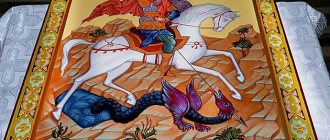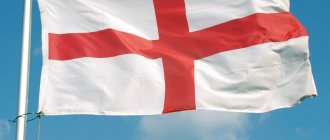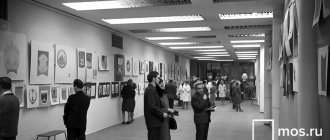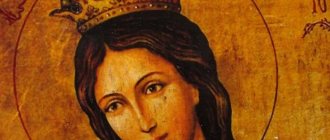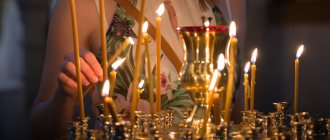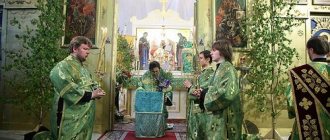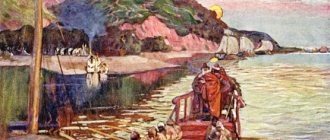Approved by whom and when
Portrait of Catherine II.
Fedor Rokotov. 1770 Empress Catherine II November 26 (December 7), 1769 in honor of the Holy Great Martyr George.
In Rus', the saint has long been revered as the protector of the Orthodox army. The son of Grand Duke Vladimir Yaroslav the Wise, baptized George, was the first to promote the veneration of St. George the Victorious among the Orthodox. He founded the Yuryevsky Monastery in Novgorod, as well as the Church of St. George in Kyiv. Empress Catherine II, who approved the order, placed it on herself, becoming the first holder of the order of the 1st degree and the first person to have this award.
Order of St. George.
“We are Russians, what a delight!” (A.V. Suvorov).
Order of St. George.
Date of establishment: November 26 (December 7), 1769 Founder: Catherine II Status: the highest military order for military merit Motto: “For service and courage” Number of degrees: 4 Ribbon: yellow-black Statute: the highest military order for military merit Rules wearing: First degree - a star on the chest on the left and a large cross on a garter over the shoulder on the right; Second degree - a star on the left and a large cross on the chest, located on a ribbon around the neck; Third degree - a small cross on a ribbon around the neck; The fourth degree is a small cross in the buttonhole or on the bar.
Empress Catherine II established the highest officer order of the Russian army - the Order of the Holy Great Martyr and Victorious George. The design of the order was developed by the hero of the Seven Years' War, Count Z.G. Chernyshev.
According to the statute, the Order of St. George was intended to reward military ranks “... for courage, zeal and zeal for military service and for encouragement in the art of war” and was immediately after the Order of St. Andrew the First-Called in importance. It was established that “...neither high family, nor previous merits, nor wounds received in battles are accepted in respect when awarding the Order of St. George for military exploits; it is awarded only to the one who not only fulfilled his duty in everything according to the oath , honor and duty, but on top of this he marked himself for the benefit and glory of Russian weapons with a special distinction.”
The order had four degrees:
Order and Star of St. George, 1st degree.
Order of St. George, 1st degree.
1st degree: cross, star and ribbon. The cross is gold, covered on both sides with white enamel, with a gold border around the edges. In the central circle, filled with red enamel, there is an image of St. George on a white horse, slaying a dragon with a spear. On the reverse side, in a white circle, is the monogram of St. George (in the intertwined letters SG). The star of the order is golden quadrangular (diamond-shaped), formed by 32 golden (solar) rays emanating from the center. In the middle of it, on a gold background, there is a similar monogram of St. George, and on a black hoop around it, the motto of the Military Order “For Service and Bravery” is written in gold letters. The cross was worn on a 10-11 cm wide moire ribbon with three black and two orange stripes, which was worn over the right shoulder.
Order of St. George, 2nd degree.
2nd degree: golden cross and golden star, similar to the first degree. The cross was worn around the neck on a narrower medal ribbon.
Order of St. George, 3rd degree.
3rd degree: golden cross, similar to the senior degrees, but smaller in size. Worn around the neck on an order ribbon.
Order of St. George, 4th degree.
Order of St. George, 4th degree.
Order of St. George, 4th degree for non-believers.
4th degree: a golden cross slightly smaller than that of the third degree. Worn in a buttonhole or on the left side of the chest on a narrow order ribbon.
St. George's ribbon and the Order of St. George.
The colors of the St. George Ribbon, as some researchers believed, combined “the color of gunpowder and the color of fire...”, while others rightly pointed out that black and yellow are the state Russian colors, and it is not for nothing that the Russian coat of arms was described as follows: “A black eagle, with a crown on the heads, and at the top in the middle there is a large Imperial crown - gold, in the middle of the same eagle George, on a white horse, defeating the serpent, the epancha and spear are yellow, the crown is yellow, the serpent is black."
The Knight of St. George was granted the rights of hereditary nobility, the possibility of preferential promotion to the next rank of his choice (but only once), upon retirement, to wear a military uniform (even if he had not served the required 10-year term for this), to place on his personal coats of arms and seals the sign of the Military Order. The senior cavaliers received pensions (in addition to the salary and serviced pension): for the 1st degree - 6 pensions of 1000 rubles each, for the 2nd degree - 25 pensions for 400 rubles each, for the 3rd degree - 50 pensions 200 rubles each, and for the 4th degree - 300 pensions of 150 rubles each.
Catherine 2 reserved the award of the Order of St. George of the first two degrees to herself personally, the discussion of the rights to receive the order of the 3rd or 4th degree was assigned to the land and naval colleges, and since 1782 this responsibility became the prerogative of the Cavalier Chapter or the St. George's Duma. In 1913, the right to award the 4th degree was given to army and navy commanders (as provided by the State Duma). Regimental priests could be awarded for their exploits with gold pectoral crosses on the St. George ribbon.
Especially for the meeting of the Cavalry Duma, a special building was established, which housed the administration of the order, the archive, the press and the order’s treasury, and Nicholas I built the St. George Hall in the Grand Kremlin Palace. There were also St. George's Halls in St. Petersburg in the Winter Palace and in the General Staff building.
The very first holder of the Order of St. George (not counting, of course, Catherine II herself) was on December 8, 1769, Lieutenant Colonel of the 1st Grenadier (later Life Guards Grenadier) Regiment Fyodor Ivanovich Fabritsian - “... for the defeat of the detachment entrusted to him (detachment) 1600 people near the city of Galati, November 15, 1769, very crowded against the number of enemy troops and taking possession of it.” The brave warrior received the 3rd degree of the order.
The Order of the 4th degree was first received by the Prime Major of the Kargopol Carabinieri Regiment, Reinholt von Patkul, awarded on February 3, 1770 “... for the excellent courage he showed against the enemy during the defeat of a very populous party of Polish rebels on January 12, 1770 at the town of Dobre.”
The Order of the 2nd degree was first awarded on July 27, 1770 to Lieutenant General Pyotr Grigorievich Plemyannikov “... for the example of courage that served his subordinates in overcoming labor, fearlessness and winning victory over the enemy on July 21, 1770 near Cahul.”
The first knight of the 1st degree was Pyotr Aleksandrovich Rumyantsev for the crushing defeat of Turkish troops at Ryaba Mogila, Larga and Kagul (summer 1770). In total, 25 people received 1st degree of the Russian Military Order, including Catherine II and Alexander II. Among the eight foreign holders of the order were Field Marshal Blücher (Prussia) and Field Marshal General Wellington (Great Britain) who defeated Napoleon at the Battle of Waterloo on June 18, 1815.
Full Knights of the Order of St. George, i.e. In the entire history of Russia, there were four who received badges of all degrees: - Field Marshal Mikhail Illarionovich Golenishchev-Kutuzov, Prince of Smolensk; - Field Marshal General Count Mikhail Bogdanovich Barclay de Tolly; - Field Marshal General Count Ivan Fedorovich Paskevich-Erivansky; - Field Marshal General Ivan Ivanovich Dibich-Zabalkansky.
Over the 148 years of its existence, only 121 people have been awarded the Order of St. George, 2nd degree. Infantry general Mikhail Dmitrievich Skobelev had three Georges. During its entire existence, only 647 people received the Order of the 3rd degree. Over the course of a hundred years, from 1769 to 1869, only 2,239 people, including 166 foreigners, received the Order of St. George, 4th degree.
Special insignia were five gold crosses worn on St. George ribbons (they were awarded to officers nominated for the Order of St. George or St. Vladimir, but who did not receive them): - “For service and bravery - Ochakov was captured on December 5, 1788”; - “For excellent courage - Ishmael was captured on December 11, 1790”; - “For labor and courage - Prague was taken on October 24, 1794”; — “Victory at Preussisch-Eylau 27 Gen.” 1807"; — “For excellent courage during the capture of Bazardzhik by attack on May 22, 1810.”
In 1805, the first collective St. George's awards appeared - St. George's Banners (standards) and St. George's Trumpets. The badge of the Order of St. George was installed in the spear of the banner staff, narrow St. George ribbons with lanyards were hung on the top, and an inscription was made on the panel, for which such a distinction was received. The St. George trumpets were made of silver, with the St. George Cross and the corresponding inscription on them, and order ribbons were hung on them. In 1814, the St. George's Bunchuk of the Don Army was established. In 1864, St. George's buttonholes were installed for lower ranks, in 1878 - St. George's ribbons for military sailors (still preserved on the caps of sailors of the guards units).
Other awards with St. George's ribbon.
The highest collective award was established in 1878. The banners and standards were decorated with a wide St. George ribbon, a cross and a star of the 1st degree of the Military Order. This award was given to the 17th Nizhny Novgorod Dragoon Regiment and the 18th Seversky Dragoon Regiment, which had especially distinguished itself in the Russian-Turkish War. In 1913, the Golden Arms of St. George were added to the Military Order.
Golden Arms of St. George "For Bravery".
St. George's Cross.
The insignia of the Military Order is an award assigned to the Order of St. George for lower ranks from 1807 to 1917 for military merits and for courage shown against the enemy. The insignia of the Military Order was the highest award for soldiers and non-commissioned officers. From June 24, 1917, it could also be awarded to officers for feats of personal bravery by honoring a general meeting of soldiers of a unit or sailors of a ship.
Since 1913, the official name has been enshrined in the statute - St. George's Cross. Until 1913, in addition to the official one, it had other, unofficial names: St. George's Cross of the 5th degree, soldier's St. George's Cross, soldier's George (“Egory”), etc.
The idea of establishing a soldier’s award was expressed in a note submitted on January 6, 1807 addressed to Alexander I (author unknown), which proposed establishing “... a 5th class or a special branch of the Military Order of St. George for soldiers and other lower military ranks... which may consist , for example, in a silver cross on the St. George ribbon, threaded into a buttonhole.” The insignia of the Military Order was established on February 13 (25), 1807, by the manifesto of Emperor Alexander I, as a reward for lower military ranks for “undaunted courage.” Article 4 of the manifesto ordered that the insignia of the Military Order be worn on a ribbon of the same colors as the Order of St. George. The badge had to be worn by its owner always and under all circumstances, but if the holder of the badge was awarded the Order of St. George, in 1807-1855 the badge was not worn on the uniform.
When it was established, the Soldier's Cross did not have degrees, and there were also no restrictions on the number of awards one person could receive. At the same time, a new cross was not issued, but with each award the salary increased by a third, to double the salary. Unlike the officer's order, the soldier's award was not covered with enamel and was minted from silver of the 95th standard (modern 990th standard).
By decree of July 15, 1808, holders of the insignia of the Military Order were exempted from corporal punishment. The insignia could be confiscated from the recipient only by court and with mandatory notification of the emperor.
There is a known case of a general being awarded a soldier's award. It became M.A. Miloradovich for the battle with the French in the soldier ranks near Leipzig. Emperor Alexander I, who observed the battle, presented him with a silver cross.
In January 1809, cross numbering and name lists were introduced. By this time, about 10 thousand signs had been issued. By the beginning of the Patriotic War of 1812, the Mint had produced 16,833 crosses. The statistics of awards by year are indicative: 1812 - 6783 awards; 1813 - 8611 awards; 1814 - 9345 awards; 1815 - 3983 awards; 1816 - 2682 awards; 1817 - 659 awards; 1818 - 328 awards; 1819 - 189 awards.
From March 19, 1855, the badge was allowed to be worn on the uniform by its owners who were subsequently awarded the Order of St. George.
On March 19, 1856, four degrees of the sign were introduced by imperial decree. The badges were worn on the St. George ribbon on the chest and were made of gold (1st and 2nd art.) and silver (3rd and 4th art.). Externally, the new crosses differed in that the words “4 degrees” and “3 degrees” were now placed on the reverse. etc. The numbering of characters began anew for each degree. Awards were made sequentially: from junior to senior degrees. However, there were exceptions. So, on September 30, 1877, I.Yu. Popovich-Lipovac was awarded the 4th degree Badge for courage in battle, and on October 23, for another feat, he was awarded the 1st degree.
If all four degrees of the sign were present on the uniform, the 1st and 3rd were worn; if the 2nd, 3rd and 4th degrees were present, the 2nd and 3rd were worn; if the 3rd and 4th were present, the only 3rd.
Over the entire 57-year history of the four-degree Badge of Distinction of the Military Order, about 2 thousand people became its full cavaliers (holders of all four degrees), about 7 thousand were awarded the 2nd, 3rd and 4th degrees, the 3rd and 4th 1st degree - about 25 thousand, 4th degree - 205,336. Most awards were received during the Russian-Japanese War of 1904-1905 (87,000), Russian-Turkish War of 1877-1878 (46,000), Caucasian Campaign (25,372) and Central Asian campaigns (23,000).
In the years 1856-1913, there was also a version of the Military Order Insignia for awarding lower ranks of non-Christian religions. On it, the image of St. George and his monogram were replaced by a double-headed eagle. 19 people became full holders of this award, 269 people received the 2nd, 3rd and 4th degrees, 821 received the 3rd and 4th degrees, and 4619 received the 4th. These awards were numbered separately.
In 1913, a new statute for the insignia of the Military Order was approved. It began to be officially called the St. George Cross and the numbering of signs began anew from that time. Unlike the Insignia of the Military Order, there were no St. George crosses for non-Christians - all crosses since 1913 have depicted St. George. In addition, since 1913, the St. George Cross could be awarded posthumously.
St. George's Cross, 3rd degree.
Full St. George's bow.
Infrequently, it was practiced to award the same degree of the St. George Cross several times. Thus, ensign of the Life Guards of the 3rd Infantry Regiment G.I. Solomatin was awarded two St. George Crosses of the 4th degree, two of the 3rd degree, one of the 2nd degree and two of the 1st degree.
The first award of the 4th degree St. George Cross took place on August 1, 1914, when cross No. 5501 was awarded to the clerk of the 3rd Don Cossack Regiment, Kozma Firsovich Kryuchkov, for a brilliant victory over 27 German cavalrymen in an unequal battle on July 30, 1914. Subsequently, K.F. Kryuchkov also earned the other three degrees of the St. George Cross in battles.
Foreigners who served in the Russian army were also awarded the Cross of St. George. The French black Marcel Plea, who fought on the Ilya Muromets bomber, received 2 crosses, the French pilot Lieutenant Alphonse Poiret received 4, and the Czech Karel Vashatka was the owner of 4 degrees of the St. George Cross, the St. George Cross with a laurel branch, St. George medals of 3 classes, the Order of St. George 4th degree and St. George's weapon.
From 1914 to 1917 the following were awarded (that is, mainly for exploits in the First World War): St. George's Crosses of the 1st Art. - about 33 thousand St. George crosses of the 2nd art. - about 65 thousand St. George crosses of the 3rd art. - about 289 thousand St. George crosses of the 4th art. - about 1 million 200 thousand.
After the February coup, cases of awarding the St. George Cross for purely political reasons began to occur. Thus, the award was received by non-commissioned officer Timofey Kirpichnikov, who led the rebellion of the Volyn Life Guards Regiment in Petrograd, and Russian Prime Minister A.F. Kerensky was “presented” with crosses of the 4th and 2nd degrees as “the intrepid hero of the Russian Revolution, who tore down the banner of tsarism."
On June 24, 1917, the Provisional Government changed the statute of the Cross of St. George and allowed it to be awarded to officers by decision of soldiers' meetings. In this case, a silver laurel branch was attached to the ribbon of signs of the 4th and 3rd degrees, and a golden laurel branch was attached to the ribbon of signs of the 2nd and 1st degrees. In total, about 2 thousand such awards were presented.
St. George's Cross with a laurel branch.
There are several known cases of awarding the Insignia of the Military Order and the Cross of St. George to entire units: - 1829 - the crew of the legendary brig "Mercury", which accepted and won an unequal battle with two Turkish battleships; - 1865 - Cossacks of the 4th hundred of the 2nd Ural Cossack regiment, who survived an unequal battle with many times superior forces of the Kokands near the village of Ikan; - 1904 - the crews of the cruiser "Varyag" and the gunboat "Koreets", who died in an unequal battle with the Japanese squadron; - 1916 - Cossacks of the 2nd hundred of the 1st Uman Koshevoy Ataman Golovatov Regiment of the Kuban Cossack Army, which, under the command of Captain V.D. Gamaliya, carried out a difficult raid in April 1916 during the Persian campaign; - 1917 - fighters of the Kornilov shock regiment for breaking through the Austrian positions near the village of Yamnitsa.
Contrary to popular belief, the Cross of St. George was not “legalized” by the Soviet government or officially allowed to be worn by Red Army soldiers. After the start of the Great Patriotic War, many older people were mobilized, among whom were participants in the First World War who were awarded the Cross of St. George. Such servicemen wore awards “in person”, in which no one interfered with them, and enjoyed legitimate respect in the army.
After the introduction of the Order of Glory into the system of Soviet awards, which was in many ways similar in ideology to the “soldier’s George”, an opinion arose to legitimize the old award, in particular, a letter addressed to the chairman of the Council of People’s Commissars and the State Defense Committee I.V. Stalin from a professor at VGIK, former member of the first Military Revolutionary Committee for Aviation of the Moscow Military District and Knight of St. George N.D. Anoshchenko with a similar proposal: “... I ask you to consider the issue of equating b. St. George cavaliers, awarded this order for military exploits committed during the last war with the damned Germany in 1914-1919, to the cavaliers of the Soviet Order of Glory, since the statute of the latter almost completely corresponds to the statute of the b. Order of George and even the colors of their order ribbons and their design are the same.
By this act, the Soviet government will first of all demonstrate the continuity of the military traditions of the glorious Russian army, the high culture of respect for all heroic defenders of our beloved Motherland, the stability of this respect, which will undoubtedly stimulate both the b. St. George's cavaliers, as well as their children and comrades, to perform new feats of arms, for each military award pursues not only the goal of equitably rewarding the hero, but it should also serve as an incentive for other citizens to perform similar feats.
Thus, this event will further strengthen the combat power of our valiant Red Army...” - Professor Nick. Anoshchenko 22.IV.1944
A similar movement ultimately resulted in a draft resolution of the Council of People's Commissars:
Draft Resolution of the Council of People's Commissars of the USSR April 24, 1944
In order to create continuity in the fighting traditions of Russian soldiers and pay due respect to the heroes who defeated the German imperialists in the war of 1914-1917, the Council of People's Commissars of the USSR decides: 1. Equate b. cavaliers of St. George, who received the Cross of St. George for military exploits performed in battles against the Germans in the war of 1914-1917, to the cavaliers of the Order of Glory with all the ensuing benefits. 2. Allow b. St. George's cavaliers wear a pad with an order ribbon of the established colors on their chest. 3. Persons subject to the effect of this resolution are issued an order book of the Order of Glory marked “b. St. George's Knight", which is formalized by the headquarters of military districts or fronts on the basis of the submission of relevant documents to them (genuine orders or service records of that time). This project never became a real resolution.
The insignia "St. George's Cross" was restored in the Russian Federation in 1992. Decree of the Presidium of the Supreme Council of the Russian Federation dated March 2, 1992 No. 2424-I “On state awards of the Russian Federation” established: “... to restore the Russian military Order of St. George and the sign “St. George's Cross.” Decree of the Presidium of the Supreme Council No. 2424-I was approved by Resolution of the Supreme Council of the Russian Federation of March 20, 1992 No. 2557-I “On approval of the Decree of the Presidium of the Supreme Council of the Russian Federation “On state awards of the Russian Federation.”
.
Great Martyr and Victorious George
- saint of the undivided Church. He lived during the time of the Roman Emperor Diocletian (284-305) and was in his military service. For professing the Christian faith, the pagan ruler ordered the saint to be tortured and then executed. The Orthodox Church celebrates the memory of the Great Martyr on May 6 and November 16.
The founder of Moscow, Yuri Dolgoruky (Yuri = George), bore the name of the saint. During the reign of Grand Duke Dimitri Donskoy, George the Victorious acts as the patron saint of Moscow, his image becomes the coat of arms of the Moscow sovereigns, and later becomes part of the Russian state emblem - the Russian Eagle. Since 1856, the image of St. George has become part of the coat of arms of the Moscow province.
For his faith, George was tortured
The next day, the tormentors found George healthy. They beat him, then tied him to a wheel with sharp hooks sticking out under it. When no amount of torment could force George to renounce Christ, he was thrown into a pit and covered with quicklime. Three days later the saint was taken out of this pit unharmed.
He still praised God. The emperor ordered him to be taken to the temple for worship, but the saint made the sign of the cross, called on God, and the idols fell from their places. In the end, Diocletian ordered the head of the great martyr to be cut off.
Saint George bravely endured all the torment and was executed.
Why was the order awarded?
According to the statute of Empress Catherine II, the award was given for special distinctions in battles, as well as for length of service in officer ranks: 25 years in field service or 18 campaigns in the sea. “Neither high breed nor wounds received in front of the enemy give the right to be awarded this order, but it is given only to those who have distinguished themselves by a particularly courageous act; this order should never be removed: for it is acquired by merit,” - from the statute of the order in 1769.
Russian-Turkish War 1768−1774. Forge of Heroes
Having approved the statute of the Imperial Military Order of the Holy Great Martyr and Victorious George, Catherine II, as the founder and head of the order, assigned herself the order for No. 1, of course, the highest 1st degree. The first award for military merit occurred just two weeks after its establishment. The lucky winner was Lieutenant Colonel Fyodor Ivanovich Fabritsian for his distinction in the battle with the Turks during the recently started Russian-Turkish war. And that's how it was.
Russian-Turkish war. Source: cont. ws
The insignificance of the successes of the Russian army against the Turks in the campaign of 1769, during which Golitsyn’s main army was limited to mainly defensive actions, while occupying Moldavia and part of Wallachia, was especially emphasized by the success of Fabritian, who managed with a small detachment to achieve the occupation of an important point on the Danube. In the fall of 1769, a Turkish corps with a force of 6-7 thousand people of selected infantry and cavalry attacked one of the Russian detachments (1,600 bayonets), sent to disturb the Turks despite the fact that the main forces (1st and 2nd armies) had already settled in winter apartments in the Danube and Dnieper regions.
The commander of the detachment, Lieutenant Colonel Fabritian, having met the enemy, despite the numerical superiority of the enemy, did not think of retreating, but rushed into battle. At some point, the position of the Russians became dangerous: the Turks took advantage of their superiority in forces (especially cavalry and artillery) and surrounded the infidels, generously showering them with cannonballs. Then Fabritian himself rushed to the Turkish battery at the head of a detachment of rangers. The servants were killed, the battery was captured, and the taken guns turned against their owners - the Russians deployed their guns and returned fire at the enemy. Soon the enemy's resistance was broken, the Turks fled, leaving everything in the hands of the Russians. artillery, two banners and several dozen prisoners, including the Moldavian ruler and the secretary of the Turkish commander.
Pursuing the enemy, the Russian detachment reached the river and immediately occupied the Galati fortress (in modern Romania). The Empress appreciated the feat of the 34-year-old officer, forever inscribing his name in the history of Russia as the first “combat” holder of the newly created order, and, in order to emphasize the courage and heroism of Fabritian, he was immediately awarded the III degree, bypassing the junior IV. A similar story, by the way, happened with Alexander Vasilyevich Suvorov a year and a half later: for his distinction in battles with the Polish confederates, he was awarded the Order of the III degree. Having risen to the rank of major general, Fabritian was appointed commander of the Russian troops in the Caucasus, but died suddenly in 1782.
Badges of the Order of St. George from the statute of 1769 Source: Shishkov S. S. Awards of Russia 1698−1917
Battle of Chesma: “George” for sailors
It is curious that in the first two years of the order’s existence, five out of twenty-five “St. Georges” of the 1st class were awarded (only 7 out of 123 of the 2nd class). One of the lucky ones, favored by the Empress, was Alexei Orlov, the leader of the overthrow of Peter III and the brother of one of Catherine’s favorites, Grigory Orlov, who received the order, contrary to expectations, not at all for his proximity to the throne. From the text of the award we read: “For brave and reasonable leadership of the fleet and winning the famous victory over the Turkish fleet on the shores of Assia and completely destroying it.” What is this “famous victory on the banks of Assia”?
We are, of course, talking about the Chesma naval battle, which took place in the summer of 1770. The coast of Assia, mentioned in the award list, is the coast of Anatolia (i.e. Asia), where the main events of the naval campaign of 1770 unfolded. In three days, the Russian fleet managed to defeat the enemy and destroy the naval power of the Turks in the Aegean Sea. Of the 16 battleships and 6 frigates that took part in the battle, the Turks lost all but one battleship! Many small ships were also lost. The Russian fleet did not know such a glorious victory even in Peter’s times. The “culprit” of the success was Count Orlov, who initiated an expedition of ships of the Baltic Fleet to the Mediterranean to strike at the sea power of the Turks and support the Greek uprising against Ottoman rule, and the immediate winner of the Turks was Admiral Grigory Spiridov.
Chesma naval battle painted by I.K. Aivazovsky. Source: wikimedia.org
It was thanks to the works of Orlov and his assistants that the Baltic Fleet, after decades of devastation, was brought into combat-ready condition, and by the summer of 1770, two Russian squadrons had already arrived in the Mediterranean, causing the defeat of the Turkish fleet in the Chios Strait and Chesme Bay on July 5-7, 1770 (according to the new style). Admiral Spiridov was awarded the Order of St. Andrew the First-Called for the victory (formally the highest award of the empire), but never received a single “George” during his career. And the Order of the 1st degree was awarded to Alexei Orlov, who exercised overall command of the Russian forces in the Mediterranean. Orders of the 2nd degree were awarded to Alexei’s brother, General Fyodor Orlov, and the direct executor of the attack of Russian fire ships, which led to the destruction of the enemy fleet, Captain (after the battle, Rear Admiral) Samuel Greig. This is how the story of “George” began in the navy, and the Chesme victory still remains one of the most glorious pages of Russian military history.
Order of the White Eagle
Order of the White Eagle
Among the first recipients of the Order were cavalry generals I. O. Witt and P. P. Palen, who distinguished themselves in the Polish campaign.
The badge of the order was worn at the right hip on a dark blue (moire) ribbon over the left shoulder, the star was worn on the left side of the chest. The Provisional Government in 1917 retained the Order of the White Eagle, but slightly changed its appearance. Instead of crowns, a blue ribbon bow appeared above the Russian imperial eagle. On the breast stars, the motto, reminiscent of the king, was replaced by laurel leaves.
The Order of the White Eagle was abolished by decree of the All-Russian Central Executive Committee in 1917. It was preserved in exile by the House of Romanov as a dynastic award.
History of the creation of the order
On January 6, 1807, in Tsarist Russia they decided to approve the St. George Cross award for soldiers by decree of Emperor Alexander the First. Then it was proposed to create 5th degree St. George Crosses for new soldiers and military personnel of lower ranks.
See also the article Guards Ribbon and its history
On February 25, 1807, it was approved by the manifesto of Alexander the First. The award was called “For courage against enemies by lower military personnel.” In the military Order it was considered a badge of honor. They were required to wear ribbons of the same colors as the Order of St. George, that is, black and yellow.
The badge was not required to be worn on the uniform if it was assigned during the period from 1807 to 1855.
The recipient of the award must always wear a cross.
Mitrokhin Egor Ivanovich was a pioneer who was awarded the Order of St. George the Victorious. Awarded for courage in 1807 in a battle against French troops near Friedland. He was a non-commissioned officer in the Cavalry Regiment. At the time of the award he held the rank of warrant officer. But it was only in 1809 that he was included in the list of recipients. And Vasily Berezkin was awarded the award even before it was approved. Awarded for bravery near Morungen on January 6, 1807.
Also, these signs were among the first to receive:
- Mikhailov - sign No. 2;
- Trekhalov - No. 5;
- Rodionov - No. 7;
- Klementyev - No. 4.
At first there were no levels in the rewards. Each soldier could be awarded an unlimited number of times. Each time a new reward was not given, but only the monetary reward was increased by 30%.
The soldier's award was not covered with enamel, only the officer's. They were minted from silver of the 95th standard (nowadays it is 990th standard). All who received the order were exempt from corporal punishment. This decision was made by the cavaliers at a meeting on July 15, 1808. Only through the court could the order be taken away from the recipient.
Photos of St. George's crosses
Translated from heraldic
Heraldry is a subsection of history that studies not only coats of arms, but also the traditions and practices of their use.
Not everyone knows, but the structure and elements of coats of arms are built on the same principles, the roots of which go back to the Middle Ages - in the period between the first and second crusades (1120-1150). Although animals and plants are often depicted on coats of arms, and this, willy-nilly, relates them to the idea of totemism among our distant ancestors, when a certain animal, element or plant was considered the forefather and a certain “head” of a particular tribe. The appearance of the coats of arms themselves is usually associated with changes in military equipment at the end of the 11th – beginning of the 12th centuries. Knights of steel wear helmets that hide their faces, and on the battlefield recognizing friends and enemies is extremely important. This is where the tradition of painting their shields with identification marks arose. They had to be simple and easily recognizable. Gradually, the rules for writing these signs emerged.
This is how the heraldic language appeared. It is a special descriptive code adopted in Western European culture for recording and describing images on coats of arms and flags. Therefore, each character in it carries meaning - just like hieroglyphs in Chinese. Let's try to understand what they mean - we'll talk about the coats of arms of Russia and the countries of the former USSR, as well as such major powers as the USA and China.
Rumyantsev-Zadunaisky - count, cavalier, winner
The second in order and the first military Order of George, 1st degree, was awarded on July 27, 1770 to General-Chief Rumyantsev, who received the honorary prefix Zadunaysky for his actions. The awarding of the field marshal (another encouragement for Cahul) with the highest military award was completely deserved: after Rumyantsev was appointed commander of the Danube, things in the army went smoothly. The experience of the Seven Years' War, during which Rumyantsev more than once distinguished himself with his management and eye, natural talents and a subtle understanding of the fundamentals of military art allowed the commander to achieve such impressive results. The victory at Kagul, won with small forces and little bloodshed thanks to Rumyantsev’s determination in the attack and the excellent training of the combat troops, forced Turkey to ask for peace (however, it never took place - in 1773 the war continued with renewed vigor) and deprived the Polish Confederates of hope of defeating the Russians and the help of the Sultan in the fight for his cause.
Rumyantsev-Zadunaisky. Star of the order under "Andrey". (pinterest.ru)
